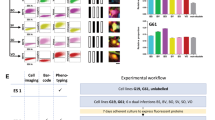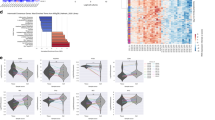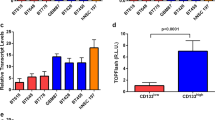Abstract
High-grade gliomas, including glioblastomas, are malignant brain tumors for which improved treatment is urgently needed. Genetic studies have demonstrated the existence of biologically distinct subsets. Preliminary studies have indicated that platelet-derived growth factor (PDGF) receptor signaling contributes to the growth of some of these tumors. In this study, human high-grade glioma primary cultures were analysed for sensitivity to treatment with the PDGF receptor inhibitor imatinib/Glivec/Gleevec/STI571. Six out of 15 cultures displayed more than 40% growth inhibition after imatinib treatment, whereas seven cultures showed less than 20% growth inhibition. In the sensitive cultures, apoptosis contributed to growth inhibition. Platelet-derived growth factor receptor status correlated with imatinib sensitivity. Supervised analyses of gene expression profiles and real-time PCR analyses identified expression of the chemokine CXCL12/SDF-1 (stromal cell-derived factor 1) as a predictor of imatinib sensitivity. Exogenous addition of CXCL12 to imatinib-insensitive cultures conferred some imatinib sensitivity. Finally, coregulation of CXCL12 and PDGF α-receptor was observed in glioblastoma biopsies. We have thus defined the characteristics of a novel imatinib-sensitive subset of glioma cultures, and provided evidence for a functional relationship between imatinib sensitivity and chemokine signaling. These findings will assist in the design and evaluation of clinical trials exploring therapeutic effects of imatinib on malignant brain tumors.
This is a preview of subscription content, access via your institution
Access options
Subscribe to this journal
Receive 50 print issues and online access
$259.00 per year
only $5.18 per issue
Buy this article
- Purchase on Springer Link
- Instant access to full article PDF
Prices may be subject to local taxes which are calculated during checkout





Similar content being viewed by others
Accession codes
References
Backlund LM, Nilsson BR, Goike HM, Schmidt EE, Liu L, Ichimura K et al. (2003). Clin Cancer Res 9: 4151–4158.
Cabioglu N, Summy J, Miller C, Parikh NU, Sahin AA, Tuzlali S et al. (2005). Cancer Res 65: 6493–6497.
Capdeville R, Buchdunger E, Zimmermann J, Matter A . (2002). Nat Rev Drug Discov 1: 493–502.
Dai C, Celestino JC, Okada Y, Louis DN, Fuller GN, Holland EC . (2001). Genes Dev 15: 1913–1925.
Demetri GD, von Mehren M, Blanke CD, Van den Abbeele AD, Eisenberg B, Roberts PJ et al. (2002). N Engl J Med 347: 472–480.
Dresemann G . (2005). Ann Oncol 16: 1702–1708.
Druker BJ, Talpaz M, Resta DJ, Peng B, Buchdunger E, Ford JM et al. (2001). N Engl J Med 344: 1031–1037.
Freije WA, Castro-Vargas FE, Fang Z, Horvath S, Cloughesy T, Liau LM et al. (2004). Cancer Res 64: 6503–6510.
Galli R, Binda E, Orfanelli U, Cipelletti B, Gritti A, De Vitis S et al. (2004). Cancer Res 64: 7011–7021.
Golub TR, Slonim DK, Tamayo P, Huard C, Gaasenbeek M, Mesirov JP et al. (1999). Science 286: 531–537.
Haas-Kogan DA, Prados MD, Tihan T, Eberhard DA, Jelluma N, Arvold ND et al. (2005). J Natl Cancer Inst 97: 880–887.
Heimberger AB, Learn CA, Archer GE, McLendon RE, Chewning TA, Tuck FL et al. (2002). Clin Cancer Res 8: 3496–3502.
Hermanson M, Funa K, Hartman M, Claesson-Welsh L, Heldin CH, Westermark B et al. (1992). Cancer Res 52: 3213–3219.
Hermansson M, Nister M, Betsholtz C, Heldin CH, Westermark B, Funa K . (1988). Proc Natl Acad Sci USA 85: 7748–7752.
Johnson BE, Janne PA . (2005). Cancer Res 65: 7525–7529.
Kilic T, Alberta JA, Zdunek PR, Acar M, Iannarelli P, O’Reilly T et al. (2000). Cancer Res 60: 5143–5150.
Kleihues P, Louis DN, Scheithauer BW, Rorke LB, Reifenberger G, Burger PC et al. (2002). J Neuropathol Exp Neurol 61: 215–225; discussion 226–229.
Kovalenko M, Gazit A, Bohmer A, Rorsman C, Ronnstrand L, Heldin CH et al. (1994). Cancer Res 54: 6106–6114.
Liang Y, Diehn M, Watson N, Bollen AW, Aldape KD, Nicholas MK et al. (2005). Proc Natl Acad Sci USA 102: 5814–5819.
Libermann TA, Nusbaum HR, Razon N, Kris R, Lax I, Soreq H et al. (1985). Nature 313: 144–147.
Mellinghoff IK, Wang MY, Vivanco I, Haas-Kogan DA, Zhu S, Dia EQ et al. (2005). N Engl J Med 353: 2012–2024.
Mischel PS, Shai R, Shi T, Horvath S, Lu KV, Choe G et al. (2003). Oncogene 22: 2361–2373.
Nutt CL, Mani DR, Betensky RA, Tamayo P, Cairncross JG, Ladd C et al. (2003). Cancer Res 63: 1602–1607.
Ohgaki H, Dessen P, Jourde B, Horstmann S, Nishikawa T, Di Patre PL et al. (2004). Cancer Res 64: 6892–6899.
Ostman A . (2004). Cytokine Growth Factor Rev 15: 275–286.
Pietras K, Ostman A, Sjoquist M, Buchdunger E, Reed RK, Heldin CH et al. (2001). Cancer Res 61: 2929–2934.
Pietras K, Sjoblom T, Rubin K, Heldin CH, Ostman A . (2003). Cancer Cell 3: 439–443.
Ponten J, Westermark B . (1978). Med Biol 56: 184–193.
Porcile C, Bajetto A, Barbieri F, Barbero S, Bonavia R, Biglieri M et al. (2005). Exp Cell Res 308: 241–253.
Reardon DA, Egorin MJ, Quinn JA, Rich Sr JN, Gururangan I, Vredenburgh JJ et al. (2005). J Clin Oncol 23: 9359–9368.
Rempel SA, Dudas S, Ge S, Gutierrez JA . (2000). Clin Cancer Res 6: 102–111.
Rich JN, Reardon DA, Peery T, Dowell JM, Quinn JA, Penne KL et al. (2004). J Clin Oncol 22: 133–142.
Sawyers C . (2004). Nature 432: 294–297.
Shamah SM, Stiles CD, Guha A . (1993). Mol Cell Biol 13: 7203–7212.
Sihto H, Sarlomo-Rikala M, Tynninen O, Tanner M, Andersson LC, Franssila K et al. (2005). J Clin Oncol 23: 49–57.
Singh SK, Clarke ID, Terasaki M, Bonn VE, Hawkins C, Squire J et al. (2003). Cancer Res 63: 5821–5828.
Singh SK, Hawkins C, Clarke ID, Squire JA, Bayani J, Hide T et al. (2004). Nature 432: 396–401.
Sjoblom T, Shimizu A, O’Brien KP, Pietras K, Dal Cin P, Buchdunger E et al. (2001). Cancer Res 61: 5778–5783.
Strawn LM, Mann E, Elliger SS, Chu LM, Germain LL, Niederfellner G et al. (1994). J Biol Chem 269: 21215–21222.
Tusher VG, Tibshirani R, Chu G . (2001). Proc Natl Acad Sci USA 98: 5116–5121.
Uhrbom L, Hesselager G, Nister M, Westermark B . (1998). Cancer Res 58: 5275–5279.
Van Gelder RN, von Zastrow ME, Yool A, Dement WC, Barchas JD, Eberwine JH . (1990). Proc Natl Acad Sci USA 87: 1663–1667.
Westermark B, Heldin CH, Nister M . (1995). Glia 15: 257–263.
Yuan X, Curtin J, Xiong Y, Liu G, Waschsmann-Hogiu S, Farkas DL et al. (2004). Oncogene 23: 9392–9400.
Acknowledgements
AÖ and MN were supported by grants from the Swedish Cancer Society, Karolinska Institutet, the Cancer Society in Stockholm and the Swedish Medical Research Council. Members of the laboratory of AÖ are acknowledged for critical discussions throughout the project and Aris Moustakas for sharing his experience in microarray analysis. The Sanger microarray consortium is funded by the Wellcome Trust, Cancer Research UK and the Ludwig Institute for Cancer Research. We thank the staff of the Sanger Institute Microarray Facility (http://www.sanger.ac.uk/Projects/Microarrays) for supplying arrays, lab protocols, and technical advice (David Vetrie, Cordelia Langford, Adam Whittaker, Neil Sutton), Quantarray/GeneSpring data files and databases relating to array elements (Kate Rice, Rob Andrews, Adam Butler, Harish Chudasama). The human IMAGE cDNA clone collection was from the MRC HGMP Resource Centre (Hinxton, UK). cDNA clone resequencing was performed by Team 56 at the Sanger Institute. Imatinib was kindly provided by Novartis.
Author information
Authors and Affiliations
Corresponding author
Additional information
Supplementary Information accompanies the paper on Oncogene website (http://www.nature.com/onc).
Rights and permissions
About this article
Cite this article
Hägerstrand, D., Hesselager, G., Achterberg, S. et al. Characterization of an imatinib-sensitive subset of high-grade human glioma cultures. Oncogene 25, 4913–4922 (2006). https://doi.org/10.1038/sj.onc.1209497
Received:
Revised:
Accepted:
Published:
Issue Date:
DOI: https://doi.org/10.1038/sj.onc.1209497
Keywords
This article is cited by
-
Altered cytoskeletal status in the transition from proneural to mesenchymal glioblastoma subtypes
Scientific Reports (2022)
-
SFRP2 induces a mesenchymal subtype transition by suppression of SOX2 in glioblastoma
Oncogene (2021)
-
Sunitinib Possible Sex-Divergent Therapeutic Outcomes
Clinical Drug Investigation (2016)
-
miRNA-21 is developmentally regulated in mouse brain and is co-expressed with SOX2 in glioma
BMC Cancer (2012)
-
Effects of Chemotherapeutics on Organotypic Corticostriatal Slice Cultures Identified by A Panel of Fluorescent and Immunohistochemical Markers
Neurotoxicity Research (2012)



